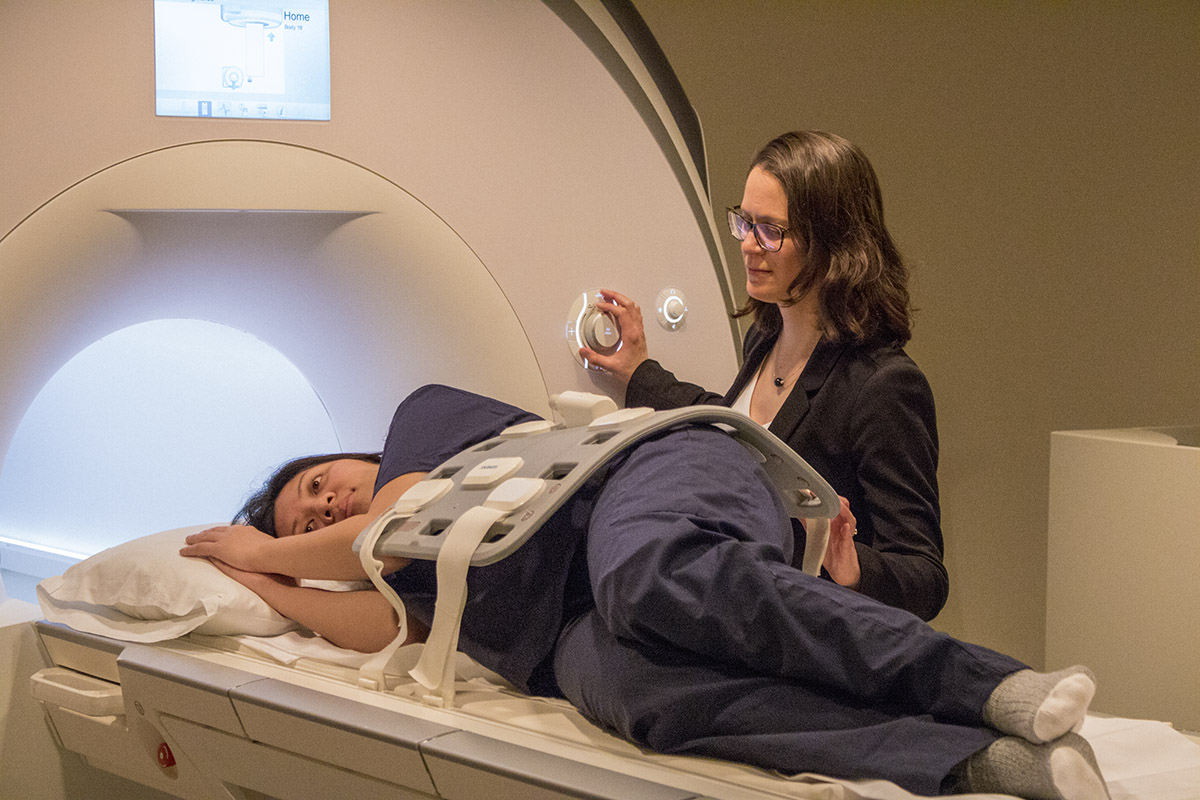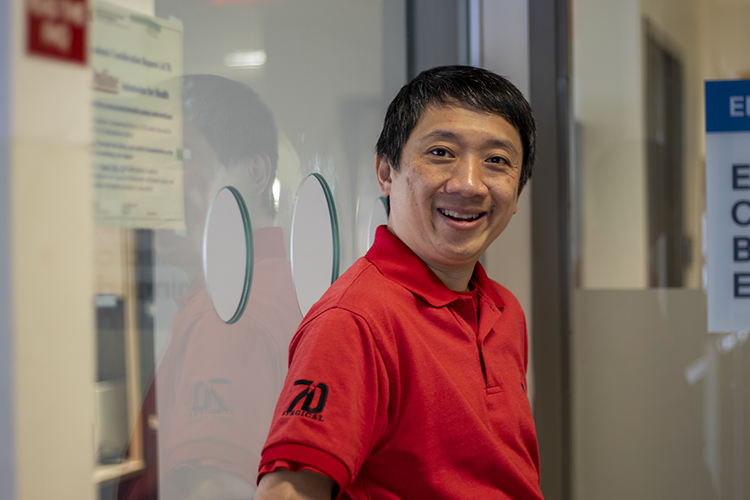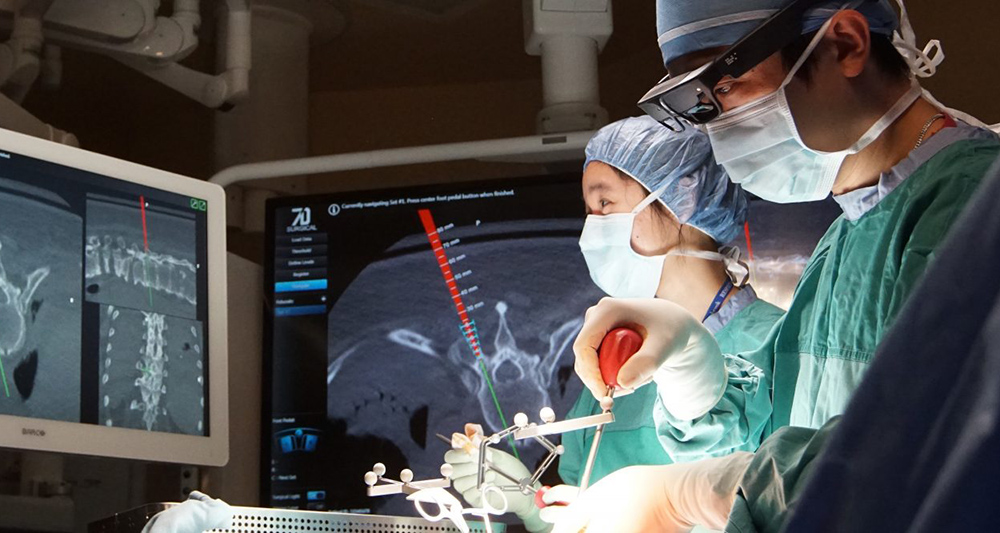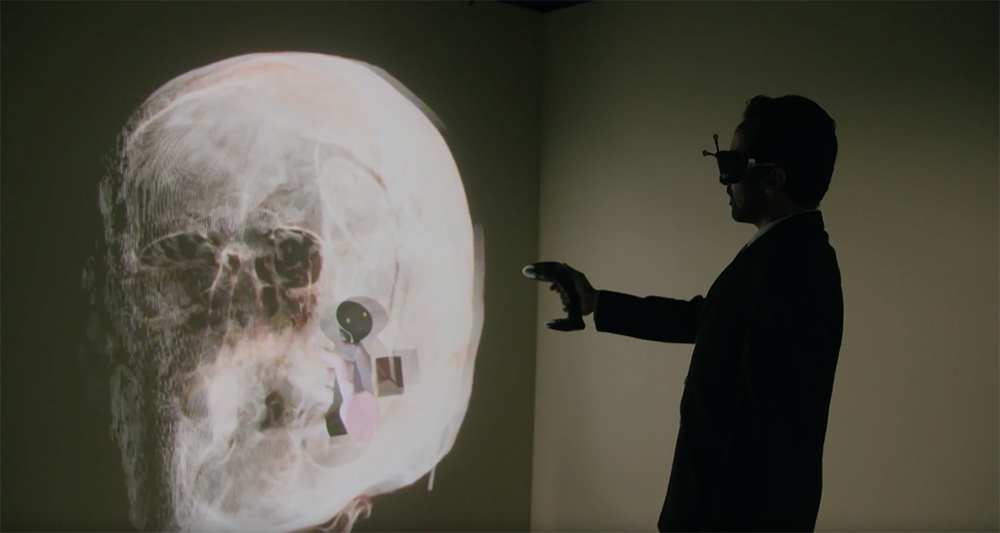Research

Our faculty and graduate students are addressing the rapidly changing needs of society. By working together – and in partnership with industry – advancements are being made in electronics, energy, artificial intelligence, computer systems, communications, multimedia and biomedical technologies. From an autonomous vehicle that acts as a personal valet to a robotic arm that helps improve the accuracy of a risky surgery, cutting-edge research is happening in the Department of Electrical, Computer, and Biomedical Engineering.

“In the Biophotonics and Bioengineering Lab, the mission is to solve a clinical need with the largest impact. We’re always asking, ‘Is there a need, do we have reasonable technology to solve that problem and is it commercially viable?’ Toronto Metropolitan University’s entrepreneurial spirit really helps.”
Dr. Victor Yang, MD, PhD, PEng, FRCSC
Professor, Biomedical Engineering
Director, Biophotonics and Bioengineering Laboratory
Laboratories and Facilities
Principal Investigator: Karthikeyan Umapathy
EPH-428A
BSIPL is advancing signal and image processing techniques, computer modelling, hyperspectral data analysis and machine learning algorithms for biomedical instrumentation and imaging applications, with a focus on ventricular arrhythmias and fibrillation.
Principal Investigator: Victor Yang
EPH-445
The Biophotonics and Bioengineering Laboratory is a multidisciplinary research group focused on the translation of novel and emerging technologies into clinical practice through close collaborations between engineers, researchers and clinicians. The lab has specialized and state-of-the-art equipment to conduct optical coherence tomography for retinal, dermal and endovascular imaging, craniospinal neuronavigation systems, robotics and augmented reality development platforms, and optical engineering facilities.
Principal Investigator: Owais Khan
EPH-426
Cardiovascular blood flow simulation and modeling techniques to understand pathophysiology of disease and design novel treatment strategies.
Principal Investigator: Cungang (Truman) Yang
EPH-443
The research lab tackles the issues in network security such as authentication, access control, communications confidentiality, integrity of messages and protection against availability attacks. The protocols and solutions developed at the lab are applied within a wide range of applications and scenarios, including Internet of Things, Wireless Sensor Networks, Vehicular Networks and Wireless Mesh Networks. Laboratory equipment includes wireless sensors, robotics, drones, GPU card, workstation and computers.
Principal Investigator: Javad Alirezaie
ENG-325
The CVIP Laboratory designs and develops algorithms in nonlinear, medical and adaptive image processing, texture segmentation, character recognition, image and video coding, and 3D computer vision. The facility is equipped with high computing power, including graphics processing units (GPUs), central processing units (CPUs) and random access memory (RAMs), for performing extensive and computational image processing projects.
Principal Investigator: Olivia Das
ENG-403
DAS Group focuses on evaluating the performance and dependability of distributed software systems through analytical modelling, simulation modelling, data-driven modelling using machine learning techniques, and measurements.
Principal Investigators: Vadim Geurkov and Lev Kirischian
ENG-415
R&D in the area of adaptive reconfigurable computing platforms on an ultra-high-performance (Giga OPS) data-stream processors.
R&D in the area of built-in self-test (BIST) and self-restoration of reconfigurable (FPGA-based) computing systems.
ERSL is dedicated to research and development in the areas of reconfigurable processing systems, with a focus on fault tolerance as well as diagnosis and troubleshooting of embedded systems. Two separate research groups are based out of ERSL: the Embedded and Reconfigurable Platforms group, led by Lev Kirischian; and the Diagnostic and Recovery of Reconfigurable Computing Platforms group, led by Vadim Geurkov. The lab itself is comprised of hardware development stations for system-level and system-on-chip development, a firmware development area, and a prototype manufacturing and verification station.
Principal Investigator: Xijia Gu
EPH-425
This lab has a optic fiber device fabrication system including a large-frame excimer laser and associated optics for fabricating fiber Bragg grating, chirped grating for pulse compression, distributed feedback (DFB) fiber laser, various fiber sensors etc. The lab also has the necessary test and measurement equipment including, optic spectral analyzers, fusion splices, fiber recoaters etc, needed to characterize those fiber divices and lasers. Over the year, the lab has deveopled the expertise for fabricating sophiscated fiber devices and DFB lasers.
The Fiber Optic Communications and Sensing Laboratory is a state-of-the-art facility for active research in the areas of fibre optic devices for high-speed broadband fibre communication, fibre optic sensing, fibre lasers and laser material processing. Equipment includes a high-energy, high-repetition rate Excimer laser, a fully-equipped fibre Bragg grating sensor writing system, and other lasers and fibre sensor equipment.
Principal Investigator: April Khademi
ENG-426
Partnering with Sunnybrook Research Institute and St. Michael’s Hospital, IAMLAB brings engineers and clinicians together to design image analysis and machine learning software tools for radiology and pathology images. Extracting insight from medical images such as magnetic resonance imaging, innovative software tools are applied to discovering disease subgroups and to describing pathology more accurately.
For more information, visit the IAMLAB website.
Principal Investigator: Ali Tavallaei
EPH-403
The research group at IGTLAB develops solutions that address significant clinical needs in image-guided therapy with a specific focus in cardiovascular interventions. In direct collaboration with clinicians and industry partners, the team designs, develops and evaluates novel devices, imaging instrumentation and navigation platforms that overcome the limitations of existing methods.
Principal Investigators: Richard Cheung, Dewei (David) Xu and Amirnaser Yazdani
ENG-327/EPH-120
Co-directed by Drs. Yazdani and Xu, located in the George Vari Engineering and Computing Centre and Eric Palin Hall, LEDAR is a state-of-the-art research laboratory equipped with electrical gear, test equipment, and simulation software. The lab is equipped with single-phase alternating current (AC), three-phase AC, and variable direct current (DC) power outlets and switchgear, with a maximum capacity of 600V/150kVA (three-phase), and various coupled motor-generator sets. Additional equipment includes high-end oscilloscopes, power analyzers, logic analyzers, programmable DC and AC sources, programmable DC and AC loads, photovoltaic array simulators, rapid prototyping platforms, electromagnetic interference (EMI) test equipment, programmable signal generators, wide-band clamp-on voltage and current probes, and conventional meters.
Principal Investigator: Ebrahim Bagheri
TEC-254
Applied Artificial Intelligence, Information Retrieval, Search Systems, Computational Semantics
LS3 provides a home for industry sponsored and/or government funded R&D work and provides learning opportunities for visiting scientists and both undergraduate and graduate students in an exciting, dynamic and challenging environment. We have three main focus areas as represented in the Labs name: System, Software and Semantics.
For more information, visit the Laboratory for Systems, Software and Semantics website (opens in new window)
Principal Investigator: Dafna Sussman
ENG-426 / Institute for Biomedical Engineering, Science and Technology (iBEST), 209 Victoria St.
Diagnostic Imaging, Maternal and Fetal Medicine, Magnetic Resonance Imaging (MRI), Ultrasound, Machine Learning, Obstetrics and Gynecology, Medical Applications of AI, Tissue Mimicking Materials, Material Engineering, Imaging Phantoms, MRI Sequences, Image processing, Medical Teaching.
Located within iBEST, a partnership between Toronto Metropolitan University and St. Michael’s Hospital, the MFI Laboratory specializes in magnetic resonance imaging techniques as they apply to materno-fetal physiology. This research team applies post-processing AI algorithms to facilitate a deeper understanding of fetal development and to permit earlier diagnosis of fetal disorders.
For more information, visit the MFI Laboratory page.
Principal Investigators: Gul Khan and Fei Yuan
ENG-313
The mission of the MSRLab is to conduct research and provide advanced training on microsystems, embedded and heterogeneous CPU-GPU systems, system-on-chip, hardware-software codesign and application-specific integrated circuits and systems. Funded by the Natural Sciences and Engineering Research Council of Canada (NSERC), CMC Microsystems, the Canada Foundation for Innovation and Toronto Metropolitan University, the lab houses two research groups: the Embedded Microsystem Design Research Group, directed by Gul Khan, and the Integrated Circuits and Systems Research Group, directed by Fei Yuan.
Principal Investigator: Marco Antoniades
EPH-402/EPH-347
Research in the Microwaves and Antennas Laboratory focuses on the design, fabrication and testing of novel electromagnetic structures. These include antennas as well as radio frequency, microwave and millimetre-wave circuits and systems for communication and biomedical applications. The lab is equipped with industry-standard computer-aided design software, high-precision mechanical and wet etching fabrication facilities, full printed-circuit-board prototyping facilities, and state-of-the-art microwave and antenna testing and characterization facilities.
Anechoic chamber for antenna and material testing and characterization. Capabilities include radiation pattern measurements, gain, radiation efficiency, and radar cross section, as well as material absorption, reflectivity and complex dielectric properties.
Principal Investigator: Bala Venkatesh
CUI-233
Through the Centre for Urban Energy, NESTNet researchers explore the future of energy storage as it applies to the global transition to clean energy. This collaborative network of 15 universities and 26 industry and government partners determines how technologies such as flywheels, lithium-ion batteries and compressed air can best be integrated into existing electricity grids, while ensuring Canadian industry remains competitive in a global marketplace.
For more information, visit the NESTNet website.
Principal Investigator: Reza Sedaghat
ENG-423
Located in the heart of downtown, OPR-AL is focused on the theory, implementation, application and development of advanced optimization approaches in communication networking and security systems, as well as very large-scale integration (VLSI) systems. Research topics include applied mathematics, the combinatorial optimization problem, the quadratic assignment problem, graph algorithms and the application of state-of-the-art technology in system synthesis.
For more information, visit the OPR-AL Lab website
Principal Investigator: Bala Venkatesh
CUI-149
Located in TMU’s Centre for Urban Energy, the Schneider Electric Smart Grid Laboratory serves as a hub for researchers and practising engineers. Housing every system component a utility distributor requires, the lab is a collaborative facility for testing and demonstrating smart grid technologies to modernize the electricity delivery system and the engagement of customers in managing their electricity usage.
For more information, visit the lab’s official website.
Principal Investigator: Sri Krishnan
EPH-439
The SAR Group explores topics in medical imaging and multimedia information as they relate to signal analysis. Technologies out of the facility include wearable devices, data acquisition systems, gait and movement analysis systems, digital signal processing boards, a soundproof anechoic chamber and brain-computer interfaces.
For more information, visit the SAR Group website.
Principal Investigator: Soosan Beheshti
ENG-403
SIP LAB conducts research in the broad areas of statistical signal processing, statistical learning theory and information theory, with focus on learning from data, data denoising, compression, and model order(complexity) detection/selection. We develop theories and algorithms for applications in data modeling and information extraction. Our methods have been applied in various areas such as biomedical signal and image processing, power spectrum estimation, and hyperspectral imaging. The group's theory and applciation tackle important issues and problems of dimention reduction, denoising, and hyperparameter selection and generalization in the area of machine learning.
Principal Investigator: Kristiina Mai
EPH-237
Exploring issues related to sustainability engineering research, the lab investigates topics at the intersection of the environment and human health, including smart irrigation and moisture testing systems for urban rooftop agriculture, which promote local food security and nutrition.
Principal Investigators: Xavier Fernando and Lian Zhao
ENG-401
The TMU ICC Lab performs cutting-edge research in the areas of optical and wireless communications. Co-directed by Xavier Fernando and Lian Zhao, the lab is home to two research groups. Fernando and his group are interested in wireless positioning sensor networking, communications in confined spaces, 5G networks, cognitive radio systems and visible light communications. Zhao and her team are advancing wireless networks to support any time, anywhere communications through artificial intelligence, mechanism design and optimization. Investigating novel approaches for adaptive network control and resource management, this research contributes to intelligent and reliable service provisioning and resource management in next-generation wireless networks.
TMU ICC Lab has secured over $5 Million in Research Grants and perform state of the art research in wireless communications. We have RF test equipment acquired through CFI grants.
Principal Investigators: Ling Guan and Naimul Khan
EPH-426
The TMU Multimedia Research Laboratory is an internationally recognized engineering lab which focuses on three key research areas: multimedia, computer vision and machine learning. Consisting of multiple postdoctoral fellows and graduate students, the research group is leading a range of projects, from computer-aided diagnosis in health care to augmented reality in entertainment and media. Funded by the Natural Sciences and Engineering Research Council of Canada (NSERC) and Ontario Centres of Excellence (OCE), the lab collaborates with industry partners across Ontario, including Dapasoft, Shaftesbury, Alcohol Countermeasure Systems Inc. and AWE Company.
For more information visit the lab’s official website.
Principal Investigator: Reza Samavi
TEC-252
Trustworthy Artificial Intelligence Research Lab (TAILab) is focused on understanding trust in machine learning algorithms from an information security perspective. While we are interested in data security and privacy research in its classical sense, in TAILab, we see data in the AI systems as a dynamic entity whose characteristics change throughout its lifecycle, from sensing, collection, and use in the learning phase to the inferencing time when it turns into a decision product. The main focus of our lab is on devising provable methods that provide algorithmic security and privacy guarantees for the data and its life cycle in machine learning algorithms, including privacy guarantees and robustness certifications. In TAILab, we are also interested in research on quantifying machine learning model uncertainty and misclassification risks when security and robustness guarantees are not attainable. Our theoretical research on trustworthy machine learning and uncertainty quantification plays a pivotal role in ensuring responsible AI deployment, particularly in safety-critical systems, such as diagnosis and health outcome prediction models, which are the applied focus of our trustworthy AI research lab.
Major research projects completed or underway in TAILab are:
- Optimization model for the robustness guarantees of DNNs.
- Model uncertainty estimation in Evidential Deep Learning.
- Conformal predictions and evidential uncertainty sets.
- Trust quantification in autonomous medical advisory systems.
- Mental health service utilization and outcome prediction for youth and children.
- Deep Learning models for cancer risk estimation from Low-Dose medical imaging radiations.
Principal Investigators: Alagan Anpalagan and Muhammad Jaseemuddin
EPH-400
Mobile Wireless Internet Group (IP networks, Mobile Wireless Networks, Internet of Things, Mobile Computing, Cloud Computing).
Equipped with state-of-the-art networking gears and OpenStack cloud platform, the WINCORE Lab offers advanced education and training in research and development within communications and networking. Areas of concentration are in radio resource management, radio access, mobile networking and mobile edge computing.
For more information, visit the WINCORE Lab website (external link) .
Principal Investigators: Vivo Valente
EPH-402
Design of CMOS-MEMS miniaturized wireless sensors for medical applications. Standard electronic equipment for hardware testing (oscilloscopes, power supplies, waveform generators, frequency counter). Fully equipped soldering stations (soldering irons, hot air gun, desoldering kit). A single-channel potentiostat (Metrohm) for electrochemical analysis. Test stand for strain gauge measurement.
For more information, visit the Wireless Sesing Lab website (external link, opens in new window)

